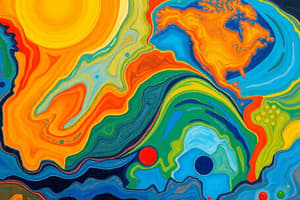Podcast
Questions and Answers
Which statement best describes the Earth among planets in the Solar System?
Which statement best describes the Earth among planets in the Solar System?
- It has a rocky surface.
- It is mostly covered with water. (correct)
- It has no atmosphere.
- It is the smallest planet.
What percentage of Earth's surface is covered by water?
What percentage of Earth's surface is covered by water?
- 90%
- 80%
- 50%
- 70% (correct)
Which of the following is NOT considered one of the Earth's subsystems?
Which of the following is NOT considered one of the Earth's subsystems?
- Biosphere
- Water sphere (correct)
- Geosphere
- Atmosphere
What is the primary function of the ozone layer?
What is the primary function of the ozone layer?
What does the geosphere encompass?
What does the geosphere encompass?
How does the biosphere influence the atmosphere and climate?
How does the biosphere influence the atmosphere and climate?
What is the geothermal gradient?
What is the geothermal gradient?
Which gas is the most abundant in Earth's atmosphere?
Which gas is the most abundant in Earth's atmosphere?
Which characteristic identifies minerals as part of Earth's natural processes?
Which characteristic identifies minerals as part of Earth's natural processes?
What is an example of a connection between the biosphere and the atmosphere?
What is an example of a connection between the biosphere and the atmosphere?
What defines the hardness property of a mineral?
What defines the hardness property of a mineral?
Which type of igneous rock forms when magma cools slowly beneath the Earth's surface?
Which type of igneous rock forms when magma cools slowly beneath the Earth's surface?
What is the role of carbon dioxide dissolving in ocean water in the context of Earth's spheres?
What is the role of carbon dioxide dissolving in ocean water in the context of Earth's spheres?
What does the term 'texture' refer to in the context of rocks?
What does the term 'texture' refer to in the context of rocks?
Which of the following properties describes a mineral's tendency to break along flat surfaces?
Which of the following properties describes a mineral's tendency to break along flat surfaces?
What is petrology the scientific study of?
What is petrology the scientific study of?
Flashcards are hidden until you start studying
Study Notes
Origin and Structure of the Earth
- Earth is uniquely supportive of life, primarily due to its abundance of water.
- Approximately 70% of Earth’s surface is covered by water.
- The planet has an optimal distance from the sun, contributing to a suitable climate.
- The atmosphere acts as a shield protecting life from harmful solar radiation.
- Earth possesses an ozone layer that absorbs harmful rays, safeguarding organisms.
Subsystems of the Earth
- The four subsystems are Atmosphere, Biosphere, Geosphere, and Hydrosphere.
- Atmosphere: Gaseous layer above Earth composed of 78% nitrogen and 21% oxygen, with trace gases like carbon dioxide and argon.
- Ozone in the atmosphere plays a crucial role in protecting living organisms.
- Biosphere: Zone where all life exists, influencing climate via photosynthesis, exchanging oxygen and carbon dioxide.
- Geosphere: Solid Earth, consisting of the core, mantle, and crust. Interior temperature increases with depth, forming the geothermal gradient (15-30°C/km for the first 100 km).
- Hydrosphere: Water component including oceans, glaciers, groundwater, and inland water.
- Matter and energy flow across the boundaries of these subsystems, indicating their interconnectedness.
- Examples of interconnections include waves eroding rocks (hydrosphere-geosphere) and carbon dioxide dissolving in oceans (atmosphere-hydrosphere).
Minerals
- Minerals are the fundamental building blocks of rocks.
- Characteristics include:
- Naturally occurring: Formed through Earth’s natural processes.
- Inorganic: Not derived from organisms.
- Homogeneous solid: Definite volume and rigid shape.
- Definite chemical composition: Can be expressed as a chemical formula.
- Orderly crystalline structure: Atoms arranged in a repeating pattern.
- Properties of minerals:
- Streak: Color in powdered form.
- Hardness: Resistance to scratching.
- Cleavage: Tendency to break along flat surfaces.
- Luster: Reflection of light from the mineral's surface.
Rocks
- Rocks are naturally occurring solid aggregates of one or more minerals.
- Most rocks consist of mixtures of different minerals, bonded chemically.
- Petrology is the study of rocks.
- Igneous Rocks:
- Komatiite: A rare ultramafic rock, very fine-grained, believed to be abundant in Earth's mantle.
- Ultramafic magma forms rocks with a phaneritic texture.
- Types of igneous rocks:
- Extrusive/Volcanic: Forms from lava cooling quickly at the surface, resulting in fine-grained crystals.
- Intrusive/Plutonic: Cools slowly beneath the surface, leading to large, coarse-grained crystals.
- Texture refers to the appearance of a rock based on the size, shape, and arrangement of mineral crystals.
Studying That Suits You
Use AI to generate personalized quizzes and flashcards to suit your learning preferences.




